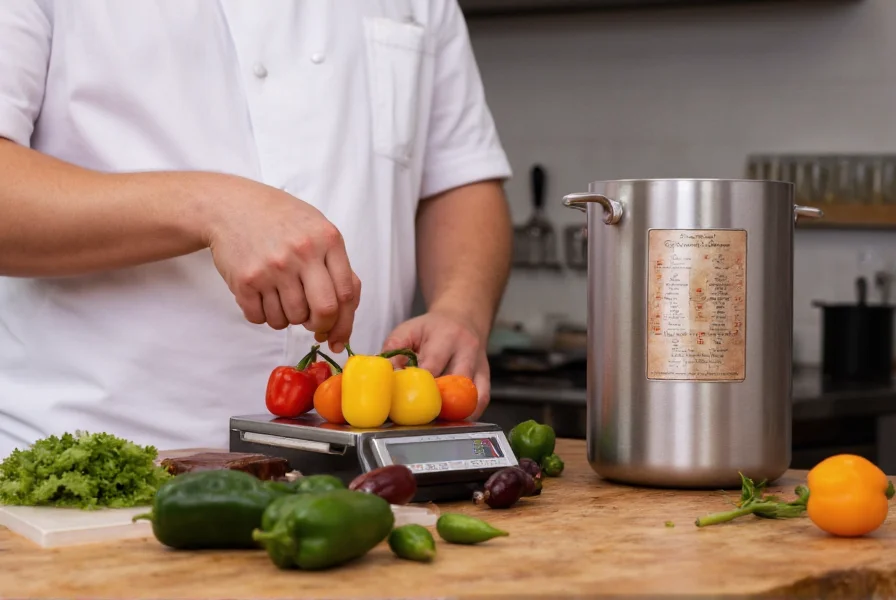The Scoville scale remains the definitive measurement system for chili pepper heat, developed in 1912 by pharmacist Wilbur Scoville. This standardized approach quantifies capsaicin concentration—the compound responsible for that burning sensation—allowing for consistent comparison across hundreds of pepper varieties. Understanding this scale transforms how you approach cooking with chilies, preventing unpleasant surprises and helping you achieve perfect flavor balance.
How the Scoville Scale Works: Science Behind the Burn
Originally, Scoville measured heat through human taste panels diluting pepper extracts until the burn became undetectable. Today, high-performance liquid chromatography (HPLC) provides precise capsaicin measurements, converted to Scoville Heat Units for consumer understanding. One part capsaicin per million equals 15-16 SHU. This scientific approach ensures accuracy across the pepper heat level chart spectrum.
Complete Pepper Chart Scoville: From Mild to Mouth-Scorching
| Pepper Variety | Scoville Heat Units (SHU) | Common Uses |
|---|---|---|
| Bell Pepper | 0 SHU | Salads, stuffed peppers, raw consumption |
| Pepperoncini | 100-500 SHU | Pickling, Greek salads, sandwiches |
| Jalapeño | 2,500-8,000 SHU | Salsas, nachos, poppers, pickled |
| Serrano | 10,000-23,000 SHU | Pico de gallo, hot sauces, guacamole |
| Habanero | 100,000-350,000 SHU | Caribbean cuisine, hot sauces, marinades |
| Ghost Pepper (Bhut Jolokia) | 800,000-1,041,427 SHU | Extreme hot sauces, competitive eating |
| Carolina Reaper | 1,400,000-2,200,000+ SHU | Specialty hot sauces, novelty challenges |
Practical Applications of the Scoville Pepper Chart
Professional chefs and home cooks rely on the scoville units chart to create balanced dishes. When developing recipes, understanding pepper heat levels prevents overpowering other flavors. For example, substituting a habanero for a jalapeño without adjustment creates an inedibly spicy dish. The chart helps identify appropriate substitutions when specific peppers aren't available.
Food manufacturers use Scoville measurements for consistent product labeling. Hot sauce producers carefully blend peppers to maintain specific heat levels across batches. This standardization builds consumer trust—when you buy a "medium" hot sauce repeatedly, you expect similar heat each time.

Safety Considerations When Handling Hot Peppers
Working with high-Scoville peppers requires precautions. Capsaicin transfers easily to skin and eyes, causing significant discomfort. Always wear gloves when handling extremely hot varieties like ghost peppers or Carolina Reapers. Never touch your face during preparation. If exposure occurs, use milk or oil-based products to neutralize the burn—water spreads capsaicin rather than removing it.
When cooking with hot peppers, remember that heat distribution isn't uniform. Seeds and white membranes contain the highest capsaicin concentrations. Removing these reduces overall heat while preserving flavor. Cooking doesn't eliminate capsaicin, but sugar and dairy ingredients can counteract perceived heat in finished dishes.
Common Misconceptions About Pepper Heat
Many believe smaller peppers are always hotter, but size doesn't reliably indicate heat level. Environmental factors like soil composition, water, and sunlight significantly impact capsaicin production. Two jalapeños from the same plant can vary dramatically in heat. The pepper spiciness chart provides general ranges, not absolute guarantees for individual peppers.
Another misconception suggests that drinking water cools your mouth after eating spicy food. Water actually spreads capsaicin, while dairy products like yogurt or milk contain casein that breaks down capsaicin molecules. This explains why cultures with spicy cuisines often serve dairy-based accompaniments.
Using the Scoville Scale for Culinary Success
Mastering the scoville heat units explained concept transforms your cooking experience. Start with milder peppers like poblanos (1,000-2,000 SHU) when developing tolerance. Gradually introduce medium-heat varieties before attempting extreme peppers. Keep a reference chart handy in your kitchen for quick consultation during meal preparation.
When creating hot sauces or spice blends, document your recipes with specific pepper varieties and their approximate SHU ranges. This record-keeping helps replicate successful combinations and avoid accidentally creating inedible dishes. Remember that personal heat tolerance varies significantly—what seems mild to one person might overwhelm another.
What is the mildest pepper on the Scoville scale?
Bell peppers rank at 0 Scoville Heat Units (SHU), making them the mildest common pepper variety. These sweet peppers contain no capsaicin, the compound responsible for heat in chili peppers. They're ideal for those sensitive to spice or for adding flavor without heat to dishes.
How accurate is the Scoville scale for comparing pepper heat?
The Scoville scale provides reliable comparative measurements, though individual peppers of the same variety can vary significantly in heat (up to 50% difference). Modern laboratory testing using HPLC ensures accurate capsaicin measurement, converted to Scoville Heat Units. For practical cooking purposes, the scale offers sufficient precision when following a comprehensive pepper chart scoville.
Can cooking reduce a pepper's Scoville rating?
Cooking doesn't reduce a pepper's actual Scoville rating since capsaicin remains stable through heat exposure. However, cooking can distribute heat more evenly throughout a dish, and certain ingredients (like dairy or sugar) can counteract the perceived heat. The physical structure breaks down, potentially releasing more capsaicin initially, but proper recipe balancing makes hot peppers more manageable in finished dishes.
Why do some jalapeños taste much hotter than others?
Jalapeño heat varies due to growing conditions—stressors like inconsistent watering, temperature fluctuations, and soil composition increase capsaicin production. Two jalapeños from the same plant can differ significantly in heat. This natural variation explains why your "mild" jalapeño recipe might occasionally become unexpectedly spicy. Checking a detailed pepper heat level chart helps set proper expectations.
What's the hottest edible pepper according to the Scoville chart?
The Carolina Reaper currently holds the Guinness World Record as the hottest edible pepper, measuring 1.4-2.2 million Scoville Heat Units. Developed by Ed Currie of PuckerButt Pepper Company, this pepper's intense heat requires careful handling. While technically edible, consuming it pure can cause severe discomfort and should only be attempted by those with high heat tolerance and proper safety precautions.










 浙公网安备
33010002000092号
浙公网安备
33010002000092号 浙B2-20120091-4
浙B2-20120091-4